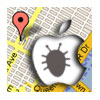![]() Apple finally sounded off on its phone tracking imbroglio on Wednesday
Apple finally sounded off on its phone tracking imbroglio on Wednesday
telling iPhone customers that “it’s the location, stupid.” The company
claims its tracking feature is designed to collect data on cell towers
and wifi hotspots, not users.
After more than a week of silence, the notoriously secretive Cupertino, California company issued a detailed FAQ (Frequently Asked Questions) list early Wednesday addressing public concerns about a hidden iPhone feature that tracked the location of iPhone users globally, recording what cell towers and WiFi hot spots they checked into and when. In its FAQ, Apple said it does not and will not track the location of customers’ iPhones. The company took the blame for not providing adequate information and education about the location tracking features, and for a bug in its location feature that resulted in iPhones storing all of a user’s location information.
The company has faced class action lawsuits, calls from customers and from U.S. lawmakers over its tracking since the feature was publicized by researchers, Pete Warden, founder of Data Science Toolkit and Alasdair Allan a researcher at Exeter University in the UK. The researchers were presenting at the Where 2.0 Conference in San Francisco in April. However, their discovery of the consolidated.db file, which was covered by major news outlets, merely reiterated information that has long been in the public domain about the iPhone’s tracking capabilities.
Apple said that the feature, which makes a note of each cellular network tower and WiFi hot spot iPhones associate with, is part of a larger, company maintained database of Wi-Fi hot spots and cell towers in the user’s vicinity. The locations of those towers “help your iPhone rapidly and accurately calculate its location when requested,” Apple said. Rather than relying on GPS to calculating a phone’s location iPhones use the information from proximate towers and hot spots to triangulate a position and reduce the amount of time it takes to find and connect to GPS satellites. When GPS service is unavailable, the location data can even be used to calculate a users location on its own.
The data from the phones, which was widely interpreted as a record of user locations, was actually a subset of a massive database of hot spots and cell towers. Data on any individual’s phone presents towers and hot spots near them, but irrespective of user movements, Apple said.
However, the company also admitted to two known bugs in the tracking feature: one that allowed phones to continuing to store address information using cell tower and WiFi hot spots even after a phone’s location services had been disabled. Another bug allowed phones to store a year’s worth of location data, rather than just a few days. Apple said it will fix those bugs in an iOS update due out in a few weeks.










